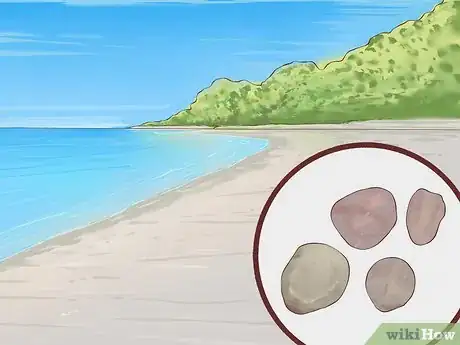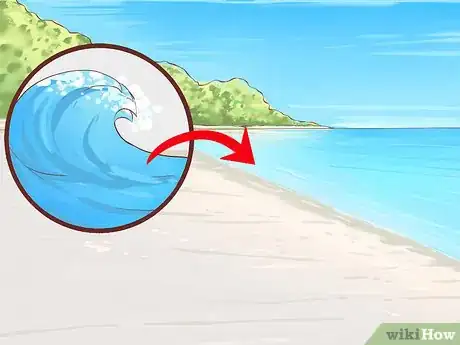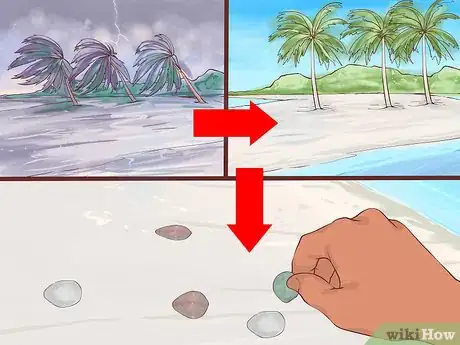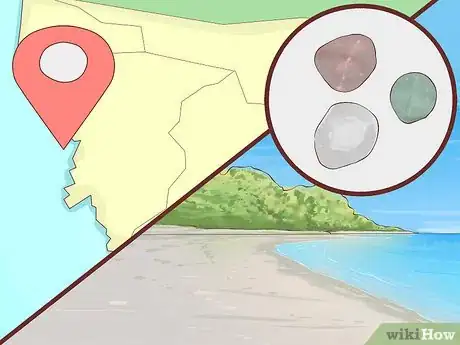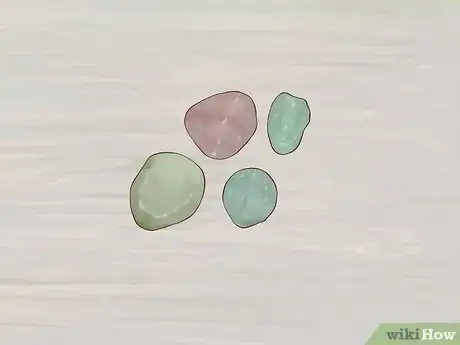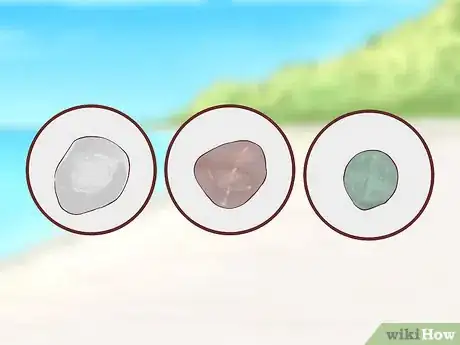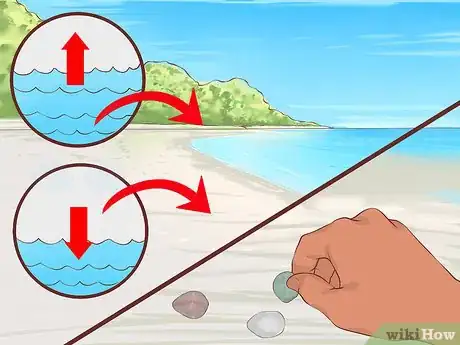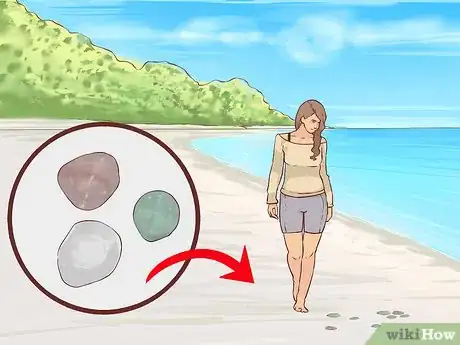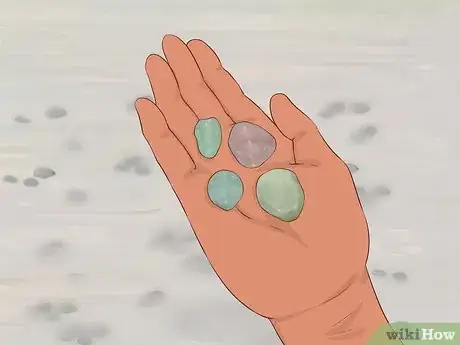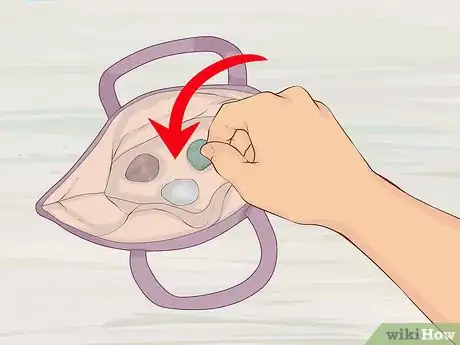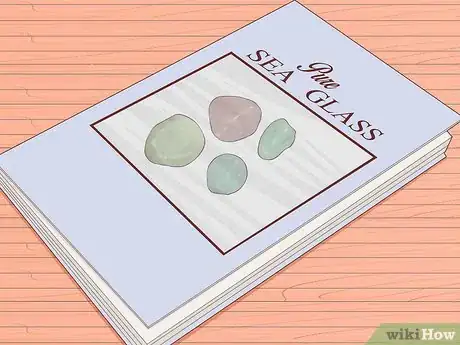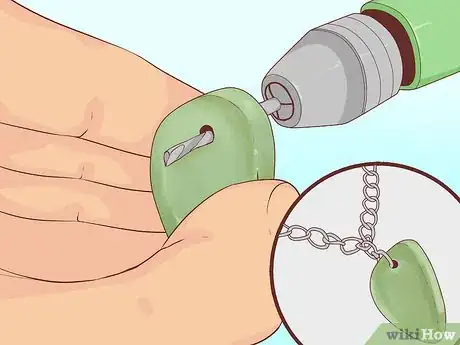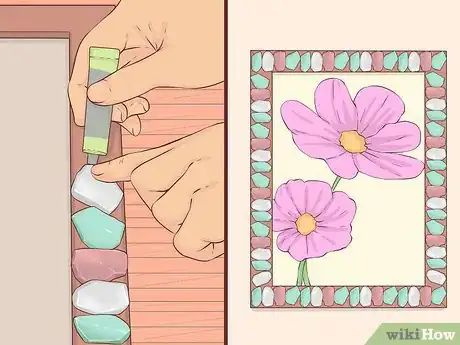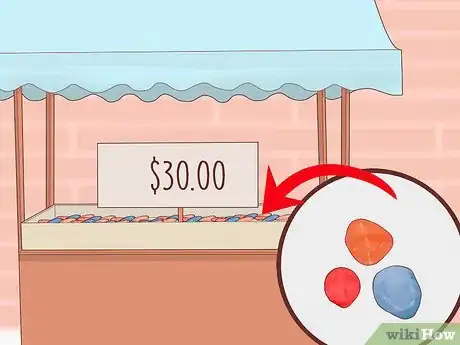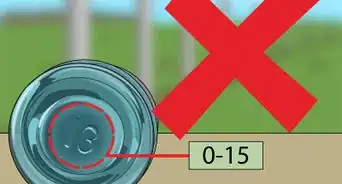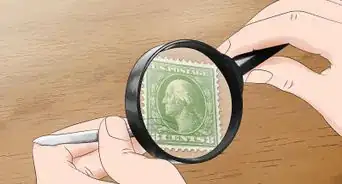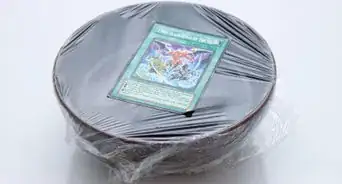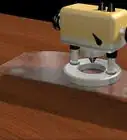This article was co-authored by wikiHow Staff. Our trained team of editors and researchers validate articles for accuracy and comprehensiveness. wikiHow's Content Management Team carefully monitors the work from our editorial staff to ensure that each article is backed by trusted research and meets our high quality standards.
There are 10 references cited in this article, which can be found at the bottom of the page.
This article has been viewed 180,492 times.
Learn more...
Collecting sea glass can be an incredibly relaxing activity! Walking down the beach of an ocean or lake will clear your mind of your everyday problems as you search for the treasured glass. Sea glass started as normal glass, usually from bottles, but after being tossed around in the waves for at least several years, it emerges smooth, polished, and frosted, making it a valuable item for collectors. To collect sea glass, you need to choose a good time and location to go, know what to look for, and find good uses for it.[1]
Steps
Choosing a Time and Place
-
1Find a beach with rocks. Sea glass accumulates where rocks (gravel) are more abundant. Look for a beach with many pebbles and you will likely find sea glass there. The same forces of nature, wind, waves and sand, that break up small rocks also create sea glass.[2]
-
2Look for a populated area. The best places to find glass are beaches close to a city or industrial/commercial zone. Sea glass starts out essentially as litter. So you want areas that are currently settled or have been in the past. This also goes for areas with lots of traffic in the sea because sea glass can come from shipwrecks or even war zones, which will produce a lot of waste.[3]
- Most sea glass started as a simple glass bottle. It begins as a manmade item before the sea polishes it into sea glass. Therefore, you need areas that have had bottles thrown in the water.[4]
Advertisement -
3Find a beach with big waves. A turbulent surf is needed to create sea glass. Areas that are regularly hit with heavy waves and winds are the best conditions to create the sea glass. The water acts as a giant rock tumbler by churning ordinary glass over time until it is polished. The bigger the waves, the better. Rough conditions will also help you to find the sea glass by moving it onto the shore.
- Go between autumn and spring. This is when the sea is likely to be the most rough.[5]
-
4Go at low tide. This will give you the best chance to find sea glass so that you can look in all areas of the beach. You can also go about an hour before or after low tide as the tide is moving, which is likely to churn up sea glass.
- During a full moon, tides will be stronger. This is helpful for the water to move the sea glass onto the shore.[6]
-
5Go after a storm. A storm will move the sea glass onto the shore. Hurricanes have been especially effective in moving large quantities of sea glass so that you can find it easily. Don't go looking for sea glass during a storm, though. Wait until it's over.
-
6Visit a beach known for sea glass. Certain beaches have a reputation for having large quantities of sea glass. These are a good place to start. Fort Bragg in California has Glass Beach, which was once a dump and now has great amounts of sea glass. Kauai Island in Hawaii has a nearby lava network that traps and polishes the glass. Bermuda has great sea glass from shipwrecks, hurricanes, and bottles thrown in the water. Puerto Rico’s Vieques is also known for sea glass.[7]
- With a location where there will likely be many people looking for sea glass, try to get there early to avoid competition.
Finding Sea Glass
-
1Look for frosted, smooth pieces of glass. You are looking for glass that has been ground and polished by sand, rock, and water erosion over many years to form an irregular shape with a dull color. If the piece you find doesn't conform to these standards, it is too new to be considered sea glass. Simply throw it back into the water.
- Distinguish between glass and sea glass. It takes at least 7-10 years for a piece of glass to become sea glass. If you’ve found a piece that has jagged edges and shiny spots, that’s still glass. Sea glass, on the other hand, is well-frosted and has smooth edges from being churned by waves over time.[8]
-
2Find the colors that you prefer. The most common colors are clear/white, green and brown. Less common colors are sky blue, blue, and indigo. Rare colors are red, yellow/amber, orange, and pink. Be aware that very tiny pieces of brown glass may look orange or amber. It is almost impossible to find true black sea glass, although dark-colored sea glass may appear black. The rarer the color, the more valuable it will be if you want to sell it later.[9]
- The best glass comes from old bottles, which are thicker and of bolder colors. The brighter colors come from wine-cooler bottles which look pretty but are very thin. The new abundance of blue glass is credited to the popularity of SKYY Vodka. Green, brown and clear are beer bottle colors.
-
3Use a small rake or stick to find more. Some people move rocks and sand around with a stick or rake. Having a small tool will help you to sort through all of the materials on the beach more quickly than with only your hands. It will also keep your hands from getting as dirty.[10]
-
4Look around low and high tide lines. Areas of wet sand are probably the best area to look in, but be aware that certain colors of glass (like white, for example) turn almost invisible when wet. This is a good place to find green or blue glass. Dry sand close to the wet sand is a great place to find white and brown colors. Also, the evasive red becomes more visible here.[11]
- Some glass is easier to find wet, while other colors are easier when dry. Green is easy to find wet or dry. White is easier when dry. Brown is easier when wet. Blue can be found wet or dry, but may look almost black when dry. Red is easier to find when dry. Amber is easier when wet. Black is always difficult to find.
-
5Look away from the shore. Dry sand far from the shore can also contain sea glass. It has the added benefit that not as many people look here. You would be amazed by the amount of glass you can find where most people are not looking for it.
-
6Look for a pocket of rocks. Walk along the beach looking for pockets of gravel. Squat or sit down. Take your time. The trick is to select a small area and scan with your eyes. Collect the glass. Move to the next promising area.
-
7Face away from the sun so that the sun is hitting the sea glass. This will help make the sea glass more visible to you and will also keep the sun from obstructing your view. The sea glass will reflect light and glisten in the sun.[12]
-
8Place pieces you choose to keep in a small bag or in your pockets. If you are only gathering a few pieces, you can keep them in your pockets. If you wish to collect a lot, bring a couple of small bags and fill them as you go.
Using Sea Glass
-
1Consult a book for specifics on your pieces of glass. Once you have collected a lot, you might not be sure which pieces are most valuable. A good book, such as Pure Sea Glass by Richard LaMotte, will help you to learn the specifics of your glass, including its origin.[13]
-
2Make sea glass jewelry. Popular jewelry items of sea glass include rings, necklaces, and earrings. You can glue the sea glass onto a ring band or earring studs. Try using a hot glue gun to adhere the sea glass securely. You could even drill holes in it to loop it through a chain or glue it to a pendant. Sea glass jewelry is elegant and beautiful, and you can also sell it.[14]
-
3Add sea glass to common items for embellishment. You can adorn many items around your house with sea glass. Glue it onto a mirror, candle holder, or drawer handle. Try making a sea glass border around a picture frame. Sea glass is great for all kinds of arts and crafts. You could even make a sea glass wind chime by hanging it on threads.[15]
- Include your kids in this. They will enjoy not only finding sea glass, but also making crafts with it. Help them glue it to a picture they draw to add decoration.
-
4Display sea glass artistically. If you collect a lot of sea glass, you can display it artfully in a clear vase, lamp base, or bowl. You could choose one color of sea glass for a uniform look or make a multicolored display. Sea glass is a beautiful decorative item that looks expensive even though you can get it for free![16]
- You could even place sea glass at the bottom of a fish tank. It will add color and visual interest to the tank.
-
5Sell it for profit. Sea glass is well-sought after and people are willing to pay for it. Rare colors such as red, dark blue, and orange will likely generate a higher profit, up to around $30 for a piece compared to around $5 for more common colors like white, green, and brown. Shape is another factor and some shapes, like hearts and triangles, are popular for making jewelry. You can make up to $15/hour by searching for sea glass and then selling it on websites like eBay or Etsy.[17]
- To help sell it, take quality pictures of it in good lighting. Try to eliminate any shadows or other distractions to the sea glass in the picture.
Community Q&A
-
QuestionWhat is the rarest sea glass?
 Community AnswerThere are different grades of sea glass and many different colors. The most rare colors are black, pink, and red.
Community AnswerThere are different grades of sea glass and many different colors. The most rare colors are black, pink, and red. -
QuestionHow is sea glass made?
 Community AnswerPeople drop normal glass bottles and the sea smashes it up. Then, the rocks and waves smooth the glass, and the pieces wash up on shore.
Community AnswerPeople drop normal glass bottles and the sea smashes it up. Then, the rocks and waves smooth the glass, and the pieces wash up on shore. -
QuestionIf I find glass that isn't frosty but came out of the water, do I throw it back?
 Community AnswerNot every piece that comes out is fully ready. If you want to keep it, you can, but check for sharp edges. If you don't want to keep it, you could throw it back.
Community AnswerNot every piece that comes out is fully ready. If you want to keep it, you can, but check for sharp edges. If you don't want to keep it, you could throw it back.
Warnings
- Never turn your back on the sea. Heed posted warnings against sleeper waves that will suddenly appear without warning that can be extremely treacherous. Beaches usually have warning signs posted,⧼thumbs_response⧽
- Be aware of your surroundings. You may focus so much on looking for glass that you may involuntarily shut down your other senses. Don't forget to watch your back for wild animals, off-leash dogs or strangers.⧼thumbs_response⧽
References
- ↑ https://bytheseajewelry.com/what-is-sea-glass-or-beach-glass/
- ↑ http://www.seaglassjournal.com/articles/findingseaglass/seaglass101.htm
- ↑ http://traveltips.usatoday.com/beaches-sea-glass-oregon-50330.html
- ↑ https://beachlust.com/collecting-sea-glass/
- ↑ http://traveltips.usatoday.com/beaches-sea-glass-oregon-50330.html
- ↑ http://www.realsimple.com/work-life/travel/sea-glass
- ↑ http://traveltips.usatoday.com/sea-glass-beaches-106573.html
- ↑ https://bytheseajewelry.com/what-is-sea-glass-or-beach-glass/
- ↑ http://www.thepennyhoarder.com/a-hobby-that-makes-money-sell-sea-glass/
- ↑ https://beachlust.com/how-to-find-more-sea-glass/
- ↑ https://beachlust.com/best-tips-sea-glass-collectors/
- ↑ https://beachlust.com/best-tips-sea-glass-collectors/
- ↑ https://www.amazon.com/dp/0975324608/
- ↑ http://traveltips.usatoday.com/beaches-sea-glass-oregon-50330.html
- ↑ http://traveltips.usatoday.com/beaches-sea-glass-oregon-50330.html
- ↑ http://traveltips.usatoday.com/beaches-sea-glass-oregon-50330.html
- ↑ http://www.thepennyhoarder.com/a-hobby-that-makes-money-sell-sea-glass/
